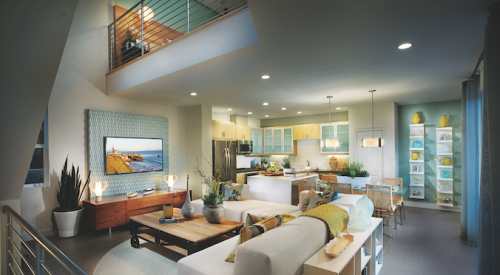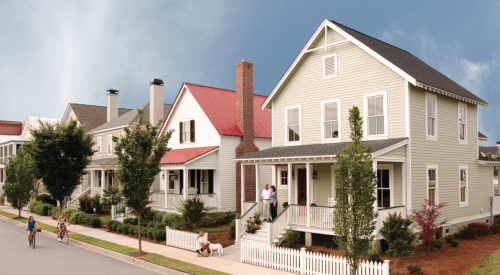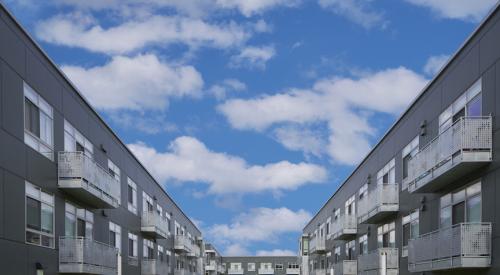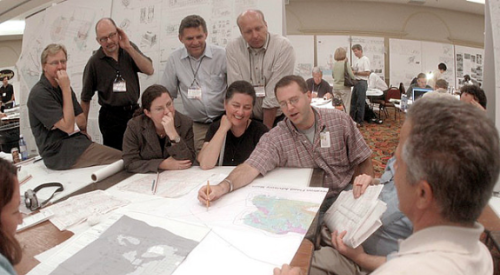|
This 2,283 square-foot Founders townhouse has a 369-square-foot optional terrace that the owner chose to finish. Optioned to the hilt, it sold for $560,000. It was one of five Founders floor plans built in Building A of Founders Mill.
Photos by Creative Sources Photography |
|
|
|
|
Three-story townhouses have terraces on the lower (garage) level that can be finished. Kitchen, living and dining rooms are on the second level, bedrooms, laundry and storage on the third. Shown here is a living room furnished by interior designer Peter Benedetto of Peter B Designs (Roswell, Ga.).
|
This infill townhouse development in suburban Atlanta is a classic example of how to turn an under-utilized site into prime residential real estate. Located on a 1.293-acre former parking lot, across the street from 19th century mill buildings near historic downtown Roswell, Ga., sit 11 elegant townhouses in two buildings that, on the outside, look like warehouses connected to the old mill operations. But inside, they are the lap of luxury, with 10-foot high ceilings, hardwood floors and granite countertops - a dream for young professionals and aging baby boomers drawn to an urban lifestyle.
Opportunities
Residential architect Lew Oliver led a group of investors that acquired this site in 2001, and thought the renovated warehouse look suited the parcel perfectly. He took that idea to his most important client, Hedgewood principal Pam Sessions, who jumped at the opportunity to acquire the site and develop it just as Oliver envisioned.
"The location is very desirable, right in the historic district of Roswell, where there's a lot of demand for infill housing close to all the shops and restaurants that make downtown so vibrant," Sessions says. "Lew Oliver does a lot of work for us. He came up with the design concept and now lives in the unit he bought for himself. We targeted urban professionals and aging baby boomers who want to live a more urban lifestyle. We knew we could sell this product at prices between $350,000 and $450,000, but first we had to sell the city on our plan."
Obstacles
The design review board of the Roswell Historical Society has to approve anything built in the historic areas that border downtown Roswell - justifiable scrutiny since history-related tourism is the primary commerce of this town. It was a target of Union General William Sherman (who burned the mill in 1864 and shipped 400 employees north as prisoners accused of treason). Fortunately, Sherman left the rest of the town's antebellum homes and buildings intact. The mill was rebuilt after the war, and the town now has 122 acres of its historic district on the National Register of Historic Places.
To match the look of the 19th century buildings still scattered around Roswell, Hedgewood had to recreate that utilitarian style of architecture. "It comes from 19th century England," Sessions says. "That style was used on all the manufacturing facilities built in Roswell between 1840 and 1890. It's very spare - simple rectangular buildings with lots of windows, aligned symmetrically, to allow the manufacturing processes as much daylight as possible. The detailing is also simple. The pilasters and corbelling we use were popular forms of ornamentation at that time - from the Greek Revival style then in vogue.
"Of course, in the 19th century, the walls would have been brick masonry," Sessions says. "And our buildings are wood-framed. We could have inset the windows - to give more of an appearance of a thick, masonry wall. But we decided it was such a subtle difference, it wasn't worth the expense. Window size, spacing and symmetry are the most important things we had to replicate."
"Some of the people on the review board liked what we proposed, some were a little nervous," says Al Causey, Hedgewood director of operations. "It took us two months of negotiations to get their approval. They even required us to use only indigenous plants in our landscaping.
"We were able to match the architecture of the late 19th century, to make the two buildings look like brick masonry warehouses that had been remodeled to subdivide them into separate residences."
Hedgewood vice president Brent Leibee managed construction, beginning late in 2002 and running through completion in September 2003. "We built it all at once," he recalls, "at hard costs averaging $70 a square foot (materials and labor), so it was really a spec job. We wanted to pre-sell more, but we didn't have a model, and people couldn't appreciate what we were doing until we got to drywall."
Outcome
Once Hedgewood reached that stage in mid-summer 2003, sales took off, at prices running from $389,000 to $434,800 (plus options), on units ranging from 2,283 to 3,115 square feet with the op-tional terrace rooms finished. "We sold them all, except for Lew Oliver's unit, in a four-month period," Leibee says. "Our average upgrade was $50,000. We equipped nine of the units with elevator shafts that were closet space until that option was taken. We priced an elevator at $28,000 and sold four of them. One buyer spent over $100,000 to finish the downstairs terrace room into a home theater."
The buyer profile hits the target perfectly. "We've got several recently retired couples," Leibee says. "Most of the rest are younger professionals."
Since completion, Hedgewood em-ployees in the area are fielding compliments about "the great job you did remodeling those old mill warehouses." Leibee says he just smiles and says, "Thanks."
Causey has a similar story: "I took my parents down there, and they asked, 'Where are the townhouses you built?' I said, 'Right there.' They said, 'No, not those, the new ones!'"
We're looking for top-selling, high-design projects to feature. Tell us about your great homes and communities at mstromberg@reedbusiness.com.











